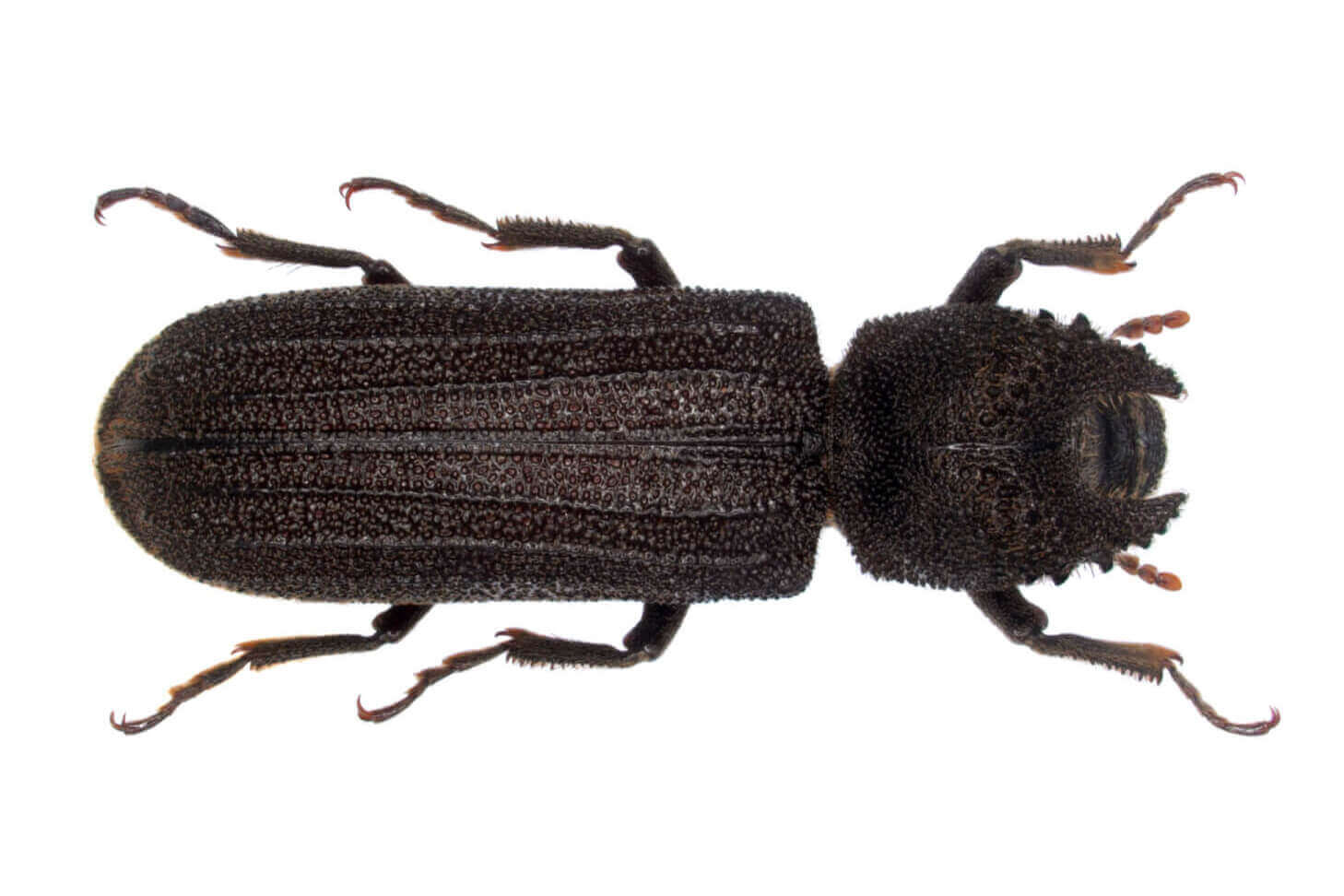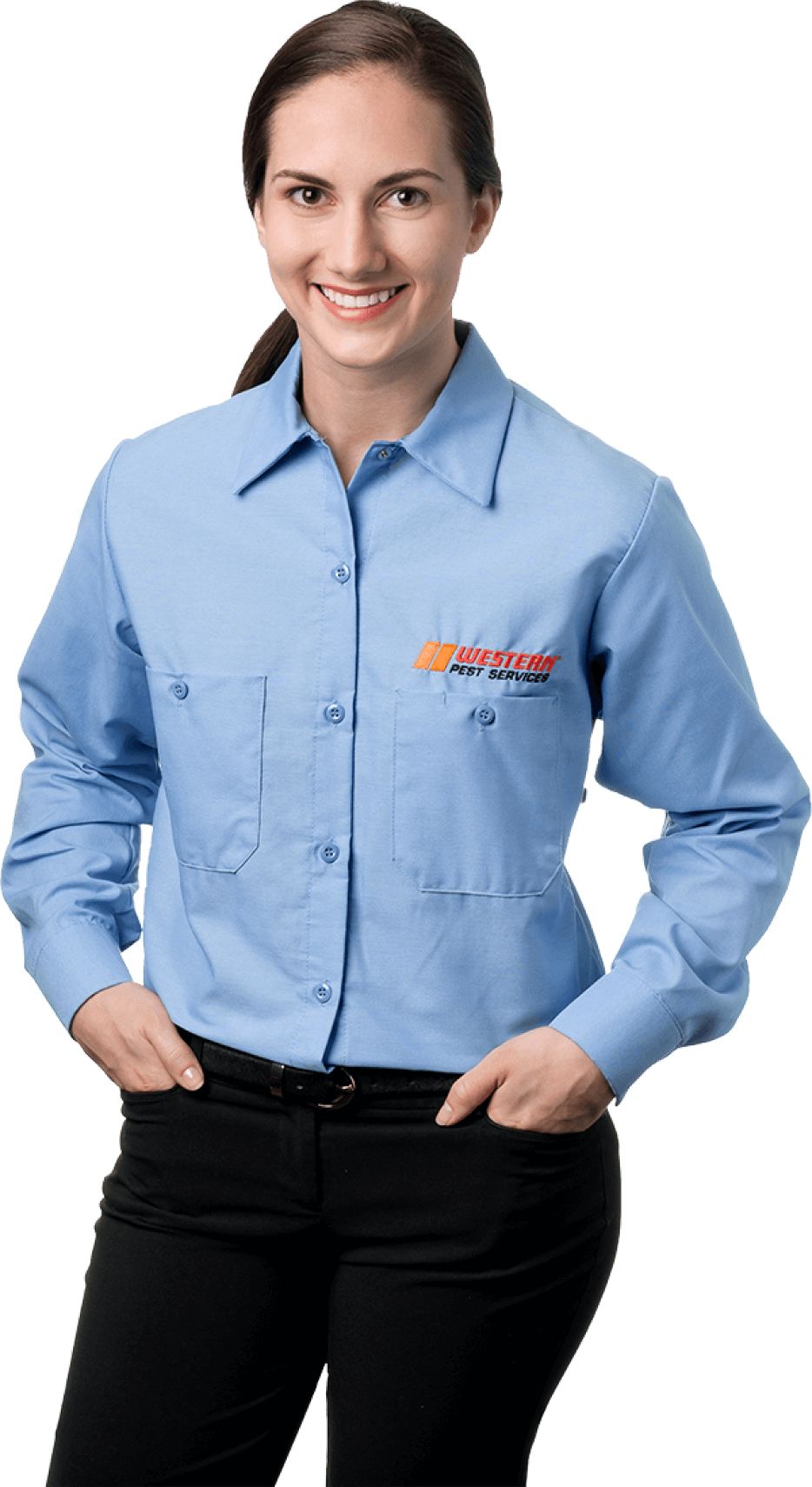Powderpost Beetle Facts & Information
Everything you need to know about powderpost beetles
what do Powderpost Beetles look like

What do powderpost beetles look like? Adult powderpost beetles range from reddish brown to black in color. They are pretty small, slender insects and therefore can be difficult to see and identify. It takes a trained eye to successfully identify them. Powderpost beetle larvae are typically white or cream colored and often recognizable by the C shape they form.
Powderpost beetles breed in dead and dried hardwoods such as the dead branches and limbs of trees. Their presence is overlooked until they are discovered in stored lumber, rafters, joists, finished wood, and furniture products. As a rule, they enter lumber while it is being stored and cured, then later, emerge from the finished product. Old items of furniture and wood antiques are especially vulnerable to attack by the beetles.
Adult beetles deposit eggs in the pores and exit holes of seasoned lumber, usually in the spring. The mature larvae are small, white grubs about 1/5-inch in length. They produce the fine sawdust mentioned previously. The larvae overwinter in the wood and reach their adult stage in spring.
Adult beetles emerge from the wood through small round exit holes. Powderpost beetles prefer the sapwood of oak and other hardwoods and many of the insects will continue to breed in an infested piece of wood for generations. This practice can result in an ultimate destruction of the wood. Powderpost beetle treatments can help if you are seeing them or the larvae around.Not the beetle you have?
Powderpost beetles breed in dead and dried hardwoods such as the dead branches and limbs of trees. Their presence is overlooked until they are discovered in stored lumber, rafters, joists, finished wood, and furniture products. As a rule, they enter lumber while it is being stored and cured, then later, emerge from the finished product. Old items of furniture and wood antiques are especially vulnerable to attack by the beetles.
Adult beetles deposit eggs in the pores and exit holes of seasoned lumber, usually in the spring. The mature larvae are small, white grubs about 1/5-inch in length. They produce the fine sawdust mentioned previously. The larvae overwinter in the wood and reach their adult stage in spring.
Adult beetles emerge from the wood through small round exit holes. Powderpost beetles prefer the sapwood of oak and other hardwoods and many of the insects will continue to breed in an infested piece of wood for generations. This practice can result in an ultimate destruction of the wood. Powderpost beetle treatments can help if you are seeing them or the larvae around.Not the beetle you have?
how did i get powderpost beetles
You could have inadvertently brought powderpost beetles in on an antique or thrift store purchase. Adult beetles deposit eggs in the pores and exit holes of seasoned lumber, usually in the spring. The mature larvae are small, white grubs about 1/5-inch in length. They produce the fine sawdust mentioned previously. The larvae overwinter in the wood and reach their adult stage in spring. So, you may not know you brought them in for a while. Be sure to thoroughly inspect purchases you’re making before bringing them home. They can also be brought in on firewood so try to only bring in what’s going directly into the fire.
where do powderpost beetles live
Powderpost beetles live and breed in hardwoods, such as the dead branches and limbs of trees. They avoid softwoods and will not attempt to tunnel in varnished woods. Often, eggs and larvae can be sealed within hardwoods, resulting in emerging adults later on. A female powderpost beetle will lay 50 eggs at a time, in the pores of the wood. When larvae of the powderpost beetle hatch, they feed on many of the various hardwoods used in furniture, baskets, hardwood trim, and flooring. Larvae will emerge one to five years later in spring. An adult powderpost beetle will not typically live for longer than a year but boy can they do some damage during that time.
what Problems do powderpost beetles cause
Powderpost beetles are not dangerous. They won’t bite you or sting you. But the damage they will do can be extensive. Some researchers believe that powderpost beetles are second only to termites in the United States in their destructiveness to wood and wood products. The powderpost beetle is what people call a wood-boring insect. The adults lay the eggs inside wood so that when they hatch the larvae has something to eat. Unfortunately, that means they eat their way out – leaving tunnels as they go. That can seriously threaten the structure that piece of wood is helping to hold up and can do serious damage to crown molding, window and door frames, hardwood floors, and furniture. Be sure to bring in a professional beetle exterminator to perform the correct powderpost beetle treatments and get ultimate powderpost beetle control.
how can i prevent powderpost beetles
Wood boring insects like powderpost beetles can be prevented through vigilant inspection of wood sources in the home. Uninfested wood which is sanded and varnished will not normally be attacked by the adult beetles because they cannot find crevices in the wood surface into which they would deposit their eggs. Items of value should not be stored in out buildings such as barns and sheds. These buildings are often infested with wood-boring beetles and if they get into your antiques and then you bring them in the house, then you are literally bringing them in the house!
Infested furniture can be fumigated in a fumigation chamber. Only pest control operators licensed to do fumigations are permitted to purchase and use these materials. Fumigants are highly effective in eliminating all stages of powderpost beetles and leave no residues in or on the wood, but will not provide any protection from future attack.
When purchasing furniture or other wooden objects, ensure the pieces are made with kiln-dried wood or wood that has been sanded and varnished. For further protection from powderpost beetles, apply paint, shellac, or varnish to any untreated wood in the home. Powderpost beetles require the moisture level of wood to be above 12%. Introducing moisture barriers into the crawlspaces of infested structures may therefore help prevent the occurrence of a powderpost beetle infestation.
Infested furniture can be fumigated in a fumigation chamber. Only pest control operators licensed to do fumigations are permitted to purchase and use these materials. Fumigants are highly effective in eliminating all stages of powderpost beetles and leave no residues in or on the wood, but will not provide any protection from future attack.
When purchasing furniture or other wooden objects, ensure the pieces are made with kiln-dried wood or wood that has been sanded and varnished. For further protection from powderpost beetles, apply paint, shellac, or varnish to any untreated wood in the home. Powderpost beetles require the moisture level of wood to be above 12%. Introducing moisture barriers into the crawlspaces of infested structures may therefore help prevent the occurrence of a powderpost beetle infestation.
WHY WESTERN for powderpost beetle control
We’re passionate about controlling beetles in your home or business because we live and work here – it’s our neighborhood, too. With our almost 100 years of experience keeping homes and businesses in Connecticut, Delaware, New Jersey, New York, and Pennsylvania safe from pests, Western has the experience you can trust.
100% Satisfaction Guarantee
24-Hour Guaranteed Response
Board Certified Entomologists
Need help with powderpost beetles?
GET MY QUOTE
